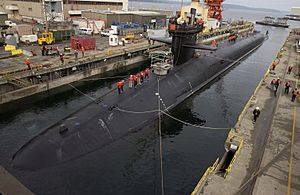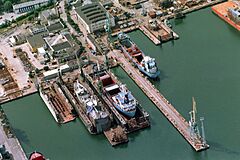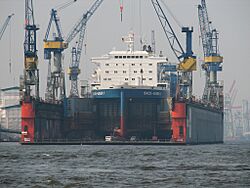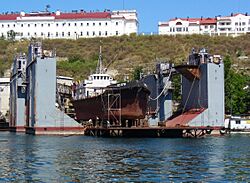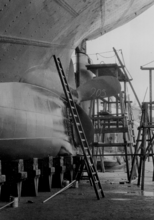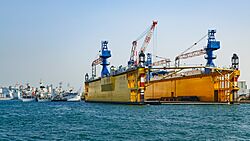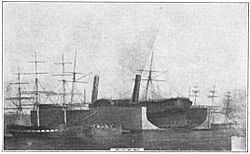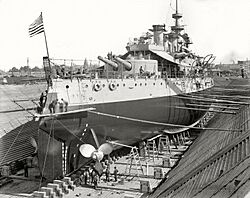Dry dock facts for kids
A dry dock is like a special parking spot for ships that lets them get out of the water. Imagine a big bathtub that can be filled with water to let a ship float in, and then drained so the ship rests on a dry platform. This allows people to work on the parts of the ship that are usually underwater. Dry docks are super important for building, fixing, and maintaining all kinds of ships, boats, and other things that float.
Contents
A Look Back in Time: History of Dry Docks
Early Dry Docks in China
People in China were using dry docks a very long time ago, even back in the 10th century. A smart person named Shen Kuo wrote about it in 1088. He described how two huge "dragon ships," each over 200 feet long, needed repairs. Since they couldn't be fixed while floating, a clever plan was made.
Workers dug a large basin near a lake and placed strong wooden beams inside. Then, they filled the basin with water so the ships could float in. After the ships were in place, the water was pumped out using special wheels. This left the ships resting on the beams, completely dry, so they could be repaired. Once the work was done, the water was let back in, and the ships floated out. The basin was even covered with a big roof to protect the ships from bad weather!
Dry Docks in Europe
Ancient Times
Some old writings from a Greek author named Athenaeus of Naucratis mention something that might have been a dry dock in ancient Egypt, around 221-204 BC. This was supposedly used to launch a giant rowing ship called the Tessarakonteres. The story says a trench was dug, filled with water to float the ship in, and then drained. However, some modern experts aren't sure if this really existed.
The Renaissance and Beyond

Before dry docks became common, ships were often "careened." This meant tilting a ship on its side on a sandy beach at low tide to work on its bottom.
The first dry dock built specifically for this purpose in Europe that is still around today was made for Henry VII of England in 1495 at HMNB Portsmouth. It was a big hole dug in the ground and lined with wood. To get a ship in, a temporary wall of rock and clay had to be dug away. This took a lot of effort! Water was pumped out using a system that might have been powered by horses. This historic dry dock still holds a ship today, the HMS M33 from World War I.
The first known description of a floating dry dock comes from a small Italian book printed in Venice in 1560. It showed a ship being lifted by two large floating structures, like a roof over the vessel, using ropes.
Modern Dry Docks
Today, dry docks are much bigger and more advanced. For example, the Saint-Nazaire's Chantiers de l'Atlantique in France has one of the largest dry docks in the world, measuring about 1200 meters long and 60 meters wide.
Germany is home to the biggest roofed dry dock, located at the Meyer Werft Shipyard. It's an amazing 504 meters long, 125 meters wide, and 75 meters tall! This allows them to build huge ships, like cruise ships, no matter the weather.
In Northern Ireland, Harland and Wolff has a huge dry dock that is 556 meters long and 93 meters wide. It's famous for its giant cranes named Samson and Goliath. The largest dry dock in the United States is Dry Dock 12 at Newport News Shipbuilding, which is 662 meters long and 76 meters wide.
Different Kinds of Dry Docks
Graving Docks

A graving dock is the most traditional type of dry dock. It's a basin, usually made of concrete, that can be closed off by large gates or a special floating barrier called a caisson.
Here's how it works:
- First, the gates are opened, and the basin is filled with water.
- A ship floats into the dock.
- The gates are closed, and powerful pumps remove all the water.
- As the water drains, the ship slowly settles onto special blocks placed on the dock floor. These blocks are carefully arranged according to the ship's "docking plan" to support its weight safely.
- Once the water is gone, the ship is completely dry, and workers can clean its bottom, remove barnacles and rust, and repaint it.
- When the work is finished, the dock is filled with water again, and the ship floats out.
It's super important that the support blocks match the ship's strong parts so the ship doesn't get damaged. Some warships have special sonar domes sticking out underneath, so they need to be supported several meters above the dock floor.
Older graving docks were often shaped like ships to make them easier to build and to support the vessels. Modern ones are usually box-shaped to fit today's larger, boxier ships.
Sometimes, dry docks used for building naval ships are covered with a roof. This helps keep secret projects hidden from spy satellites. During World War II, the German navy even used strong, covered dry docks to protect their submarines from air attacks. A big plus of covered dry docks is that work can continue no matter the weather, which is great for building expensive ships like cruise liners.
Floating Dry Docks
A floating dry dock is like a giant, U-shaped boat that can sink and rise. It has special chambers that can be filled with water.
Here's how it works:
- To dock a ship, the chambers are filled with water, making the floating dry dock sink lower into the water.
- The deck of the dry dock goes underwater, allowing a ship to float into position above it.
- Then, powerful pumps remove the water from the chambers.
- As the water is pumped out, the floating dry dock rises, lifting the ship completely out of the water.
- Once the ship is dry, work can begin on its hull.
Large floating dry docks are often made of several rectangular parts that can be connected. This means they can be made longer or shorter to fit different sizes of ships. Each part has its own equipment for pumping water and providing services. Smaller floating dry docks can even be made from old barges.
Floating dry docks are very useful in places where the ground is too soft or porous for traditional dry docks, like on the limestone islands of Bermuda. Another great thing about them is that they can be moved to different locations where they are needed, and they can even be sold to other shipyards. During World War II, the U.S. Navy used many of these floating docks to fix ships in faraway places.
One famous floating dry dock is the "Hughes Mining Barge" (HMB-1). It's a covered, floating dry dock that can also go underwater. It was used for secret projects, like helping to transfer a lifting device for the Glomar Explorer ship and developing the Sea Shadow stealth ship.
The Great Balance Dock, built in New York City in 1854, was the biggest floating dry dock in the world at the time. It was 325 feet long and could lift 8,000 tons, enough for the largest ships of its day.
Other Ways to Dry Dock Ships
Besides graving docks and floating dry docks, ships can also be lifted out of the water using:
- Marine railway: A system of rails that pulls ships out of the water on a cradle.
- Shiplift: A platform that lifts a ship vertically out of the water.
- Slipway: A ramp that allows smaller boats to be pulled ashore for repairs or new ships to be launched into the water.
Other Uses for Dry Docks
Dry docks aren't just for ships! They are also used to build other very large things, like parts of bridges and dams. For example, a dry dock on the artificial island of Neeltje-Jans in the Netherlands was used to build huge concrete pillars, each weighing 18,000 tonnes, for a big dam called the Oosterscheldekering. These pillars were built in the dry dock and then floated to their final spot in the sea.
Dry docks can also be used to build sections of underwater tunnels. These tunnel parts are made in the dry dock, floated into place, and then sunk to form the tunnel.
Gallery
-
The Royal Naval Dockyard, Bermuda in 1883, with its floating drydock in the background.
-
The towboat Dolphin I in a floating dry dock on the Mississippi River in Algiers, New Orleans, Louisiana.
-
A floating dry dock located in Sevastopol.
-
Floating dry dock Jong Shyn No. 8 in Kaohsiung Harbour, Taiwan.
See also
- List of dry docks
- Semi-submersible
- Space dock
- St Nazaire Raid — A famous 1942 attack on a dry dock during World War II.




